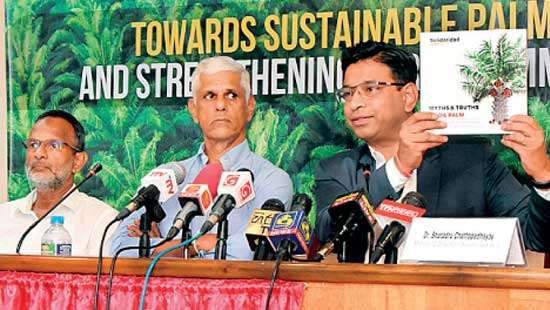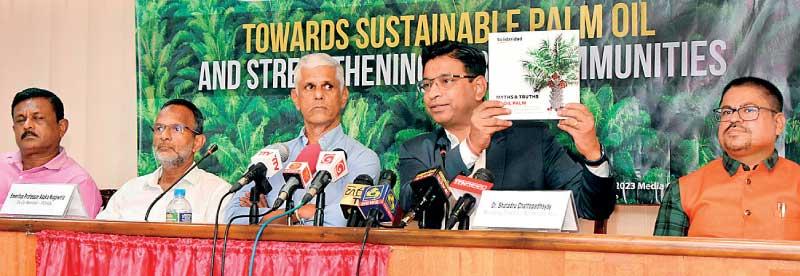Reply To:
Name - Reply Comment


Haritha Derana Smallholder Association President Nimal Wijesinghe, POUASL COO Yajith De Silva, POIASL Ex Co Member Emeritus Professor Asoka Nugawela, Solidaridad Asia Managing Director Dr. Shatadru Chattopadhayay, and APOA Secretary General Dr. Suresh Motwani - Pic by Nimalsiri Edirisinghe
By Shabiya Ali Ahlam
Sri Lanka’s Palm Oil Industry Association (POIA) and the Asian Palm Oil Alliance (APOA) yesterday called on the government to reconsider the ban on oil palm cultivation and allow its expansion so that the island nation can reap the economic benefits stemming from it.
The industry stakeholders urged the government to allow oil palm cultivation to be carried out over 20 hectares, as per the initial permit, so that the full potential of the crop can be realised. At present, the total extent of oil palm cultivation in Sri Lanka is about 10 hectares.
Following the unpopular and sudden decision taken in April 2021 by the then President Gotabaya Rajapaksa, where he announced the ban of new oil palm plantations and the uprooting of existing plantations, the present legal and regulatory impediments to cultivating oil palm stand as a lost opportunity for Sri Lanka, the stakeholders said in a joint press conference held in Colombo.
“It is crucial to thoroughly evaluate the economic benefits associated with oil palm cultivation, along with its present and potential future contributions to the GDP, rural development and alleviation of poverty,” said POIASL Ex Co Member Emeritus Professor Asoka Nugawela.
“Instead of misguided policies, without proper assessment, we should consider the positive impact palm oil can have on our nation’s sustainable development,” he stressed.
The ban on palm oil imports, and oil palm cultivation were imposed to promote the consumption of coconut oil on the misconception that the oil palm plantations have a higher water footprint, thus impacting the output of other crops in its vicinity.
In reality, in Sri Lanka, the water footprint of coconut oil is 10,548 m3 water/tonne, while for palm oil it is 3,946 m3 water/tonne, as per research carried out by Solidaridad, an international civil society organisation. Its studies also showed that there is no evidence found of soil and water resource degradation in oil palm growing estates in the island nation.
Further, the associations shared that the local production of palm oil saves for the national economy foreign exchange amounting to about US$ 27 million per year through import substitution.
By paving the way to set up and continue oil palm cultivation, the benefits for Sri Lanka are many, they pointed out.
The average profits generated per year were Rs. 900,000 for oil palm, whereas it is Rs. 280,000 for coconut, Rs. 70,000 for rubber, and Rs. 45,000 for tea.
In reality, in Sri Lanka, the water footprint of coconut oil is 10,548 m3 water/tonne, while for palm oil it is 3,946 m3 water/tonne, as per research carried out by Solidaridad, an international civil society organisation. Its studies also showed that there is no evidence found of soil and water resource degradation in oil palm growing estates in the island nation.
Further, the associations shared that the local production of palm oil saves for the national economy foreign exchange amounting to about US$ 27 million per year through import substitution. By paving the way to set up and continue oil palm cultivation, the benefits for Sri Lanka are many, they pointed out.
The average profits generated per year were Rs. 900,000 for oil palm, whereas it is Rs. 280,000 for coconut, Rs. 70,000 for rubber, and Rs. 45,000 for tea.
The daily wages per month for workers was found to be Rs. 30,000-50,000 for oil palm workers, while for tea estate workers it is Rs. 25,000 and Rs. 18,000 for rubber tappers.
The associations noted that countries such as Malaysia and Indonesia have successfully harnessed the potential of this crop, not only in terms of economic growth but also to establish sustainable, environmentally-responsible supply and value chains, empowering rural communities.
“We can fast track our success using these established and proven practices to ensure that oil palm cultivation in Sri Lanka is sustainable and in alignment with UN’s sustainable development goals,” said APOA Secretary General Suresh Motwani. To capitalie on the opportunities that oil palm cultivation presents, POIASL proposed a range of key steps for Sri Lanka to take. Most importantly, the immediate need for comprehensive stakeholder collaboration and cooperation, including government, industry and local communities, towards the establishment of a comprehensive framework for sustainable cultivation of oil palms in Sri Lanka.